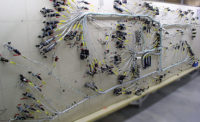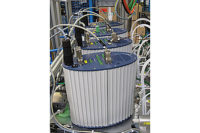Surface mount rework systems have evolved into sophisticated thermal processing tools. At a localized rework site, they can mimic the original time and temperature profile that was used to solder the entire board in a reflow oven.
Nevertheless, many sensitive components, such as optical devices, connectors and ball grid arrays (BGAs), have strict rework requirements that go far beyond the typical soldering profile. The increasing use of lead-free solder alloys only complicates the issue.
To rework these components successfully, engineers need a lot more information about their thermal behavior and temperature limitations. And, thermal management software and equipment must be adapted to follow these limitations, while observing all the requirements for good soldering. We call this process rules-based thermal profiling.
Generating thermal profiles for rework is more difficult than generating profiles for a reflow oven. When an assembly passes through a reflow oven, the entire mass is heated to a relatively uniform temperature. Belt speeds and zone temperatures can be adjusted to achieve the desired thermal profile.
Rework is different. For the most part, heating is localized to the rework site. That makes profiling more difficult, because the thermal characteristics of each component and assembly can vary considerably.
During rework, the board is heated from both the bottom and the top.
Bottom heating brings the entire board to an intermediate temperature. This minimizes stress from local heating and reduces extraction of heat from the rework site. However, because the entire board cannot be heated to reflow temperatures, it will have a lateral temperature gradient, and some heat will transfer from the rework site to surrounding areas.
Top heating is directed at the component. As the component heats, thermal energy dissipates through the board due to its heat-sinking effect, which is a function of its mass. The mass of the component and the rate of dissipation determine how much energy is needed to rework the board.
In a convection rework system, most of the heating for area array devices comes from the transfer of energy from the hot gas to the top side of the component. Heat then flows through the component body to the component-solder interface, through the solder, through the board-solder interface, and into the board. Copper conductors within the board, especially large power and ground planes, provide a substantial thermal path to draw heat away from the rework site.
To corroborate this “through-the-component” heat flow, we performed an experiment to determine the extent of heat transfer due to hot gas flowing under a BGA. A test board was constructed with a 27-millimeter plastic BGA mounted on an FR4 board. A hole was drilled into the component site from the back side, and a thermocouple was inserted to contact one solder ball. The thermocouple was secured with thermally conductive epoxy.
The test piece was then exposed to two thermal cycles with identical heater parameters. The rework nozzle was positioned flush with the board’s surface. Exhaust air deflected up and away from adjacent components. The first set of data was taken using the standard rework process. Prior to the second cycle, a thin layer of Kapton tape was placed along the component edges, sealing the gap between the BGA body and the board to prevent hot gas from flowing under the component.
The test showed that taping the gap between the BGA body and the board had no significant impact on the temperature measured at the solder joint, confirming that most heat transfer occurs via conduction through the component body rather than from hot gas flowing under the component.
How Materials Affect Heating
The flow of energy through the component can be damaging if not managed correctly. Depending on the packaging materials and construction, certain components can be especially susceptible to thermal damage due to their low thermal conductivity. Ceramic packages conduct heat far better than plastic packages. Polyimide and epoxy-based substrates have low thermal conductivity. Thermally enhanced packages, especially those with thermal via connections, conduct heat quite rapidly, thought not necessarily uniformly.
In many cases, temperature ramp rates that are acceptable in a reflow oven are unacceptable for rework because of the temperature gradient that occurs between the top and the bottom of the package. For example, the temperature at the top of a plastic BGA will be much higher than the temperature at the solder joints, due to the low thermal conductivity of the component. In contrast, the temperature at the top of a ceramic BGA will only be slightly higher than the temperature at the solder joints, because of the high thermal conductivity of the component.
Engineers should keep this in mind when planning a ramp rate for rework. Engineers must avoid exceeding maximum package temperatures in low thermal conductivity packages, such as large, plastic-encapsulated BGAs. Profiles with moderate ramp rates measured at the solder joint may cause dangerously high temperatures at the top of the package. On the other hand, packages with high thermal conductivity may ramp extremely quickly. Overly aggressive profiles may exceed ramp specifications, causing thermal stress damage.
Protecting the Component
Rules-based profiling software allows engineers to define additional parameters—beyond time, temperature and ramp rate—to protect delicate components when planning a new rework process. These parameters include maximum component temperature (usually measured at the top of the package); maximum temperature of the topside heater; maximum ramp rates; and the minimum and maximum times for flux activation and time over liquidus.
Protecting a thermally sensitive package with low thermal conductivity can be achieved by monitoring and limiting the temperature at the top of the package. By setting a rule to limit the package temperature, the normal profile parameters are automatically modified to meet the constraints set by the rule.
For example, the rework profile for a plastic BGA could include a rule limiting the temperature at the top of the package to 250 C. A thermocouple would then be attached to the top surface using a small amount of thermally conductive epoxy.
During rework, the component would be heated according to a standard BGA profile—until the temperature at the top of the package reached the specified limit. At that point, the topside heater would switch over to rules-based control. The software automatically adjusts the ramp rate to maintain the temperature within the set limit. Reflow dwell time is dynamically corrected to keep time above liquidus within the specified range. The resultant package temperature might exceed the limit by 2 degrees, but remain 15 degrees lower than the profile that was generated without application of the rule.
The ability to monitor the temperature at the top of the package and automatically correct it during the “learn” phase of profile generation is a powerful tool for protecting delicate components. If the 2-degree overshoot allowed by the algorithm exceeds acceptable profiling goals, an offset can be included in the rule to satisfy this contingency. In other words, the limit on package temperature could be set to 248 C, instead of 250 C.
Many types of components may benefit from this approach. For instance, a popular flip chip BGA construction leaves the bare circuit exposed directly to hot gas. The bodies of leaded surface mount connectors often have strict temperature limits (typically 160 C). The optical elements within fiber optic transducers and receivers quite often must be held well below reflow temperatures. In all of these cases, a temperature sensor can be attached to the sensitive areas, and rules set to maintain the profile within prescribed limits.
An Alternative Approach
There are often circumstances when attaching a thermocouple to the top of the package is inconvenient or impossible. For instance, it is impractical to permanently attach a thermocouple when a limited number of boards are to be reworked. In these cases, a simple alternative rule can be applied.
Rather than measuring the temperature at the top of the component, previously established data can be used to define the temperature relationship between the topside heater and the top of the package. This relationship is based primarily on the materials and construction of the component.
Returning to the example of the plastic BGA, trials have shown that a maximum package temperature of 250 C can be maintained by limiting the topside heater temperature to no more than 70 degrees above the solder joint temperature during the reflow portion of the rework profile. This relationship can be specified as a rule in the software.
Now, a thermocouple does not need to be attached to the package. As the profile approaches peak reflow temperature, the topside heater control maintains the specified solder joint ramp rates and temperatures. Several seconds after the solder joint passes liquidus, the temperature difference between the topside heater and solder joint reaches the maximum. At this point, the topside heater switches to rules-based control. The ramp rate is automatically modified. The reflow dwell time is dynamically adjusted to keep the profile within specified minimum and maximum time over liquidus.
In this example, the peak temperature at the top of the package is 253 C, nearly the same result as that achieved using the thermocouple. Again, the component is protected. However, for consistent results with this method, engineers must know the package materials and construction, or have experience with similar packages, in order to set the right limits.
Editor’s Note: This article was originally presented at the APEX Exhibition and Conference, March 30 to April 1, in Anaheim, CA.

